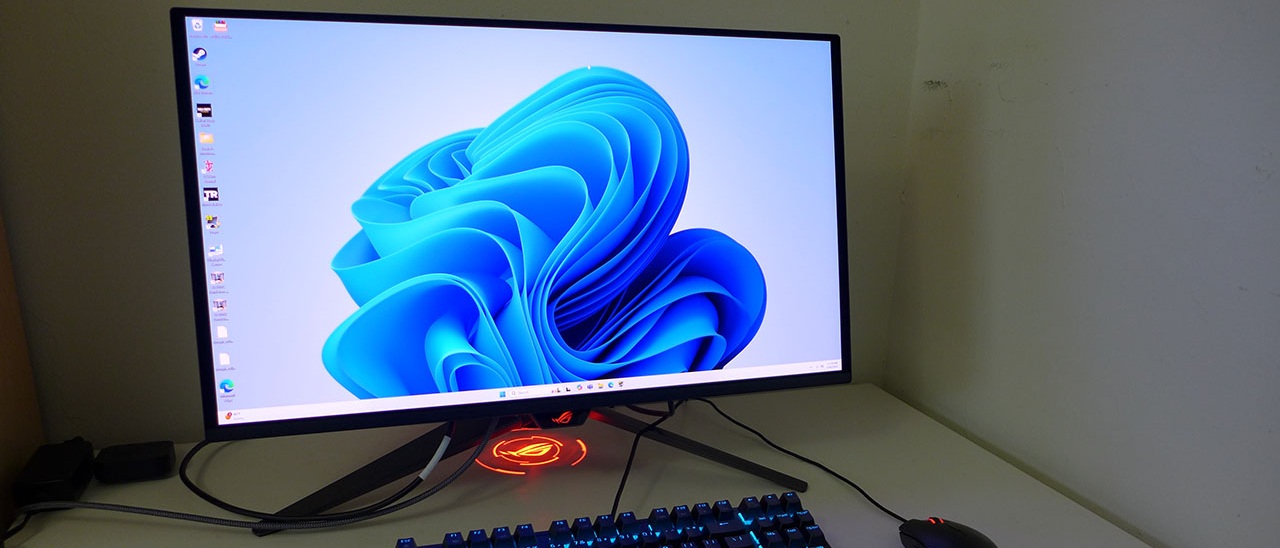Why you can trust Tom's Hardware
The PG27UCDM includes factory calibration data, and my tests confirm its out-of-box accuracy. In the default Racing mode, it does not need calibration. It also has an accurate sRGB mode and plenty of image controls for those who want or need to tweak.
Grayscale and Gamma Tracking
Our grayscale and gamma tests use Calman calibration software from Portrait Displays. We describe our grayscale and gamma tests in detail here.
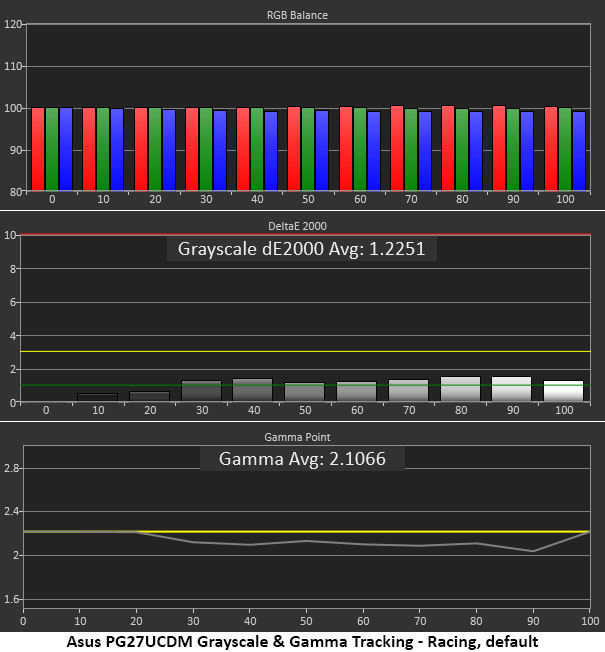
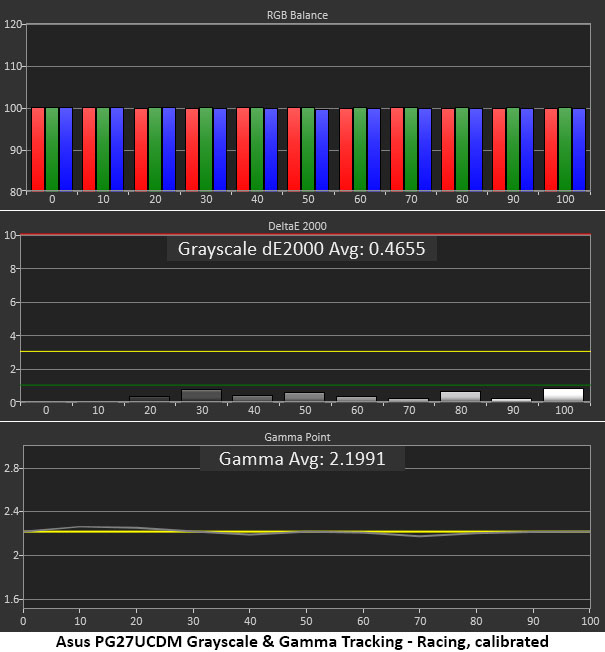
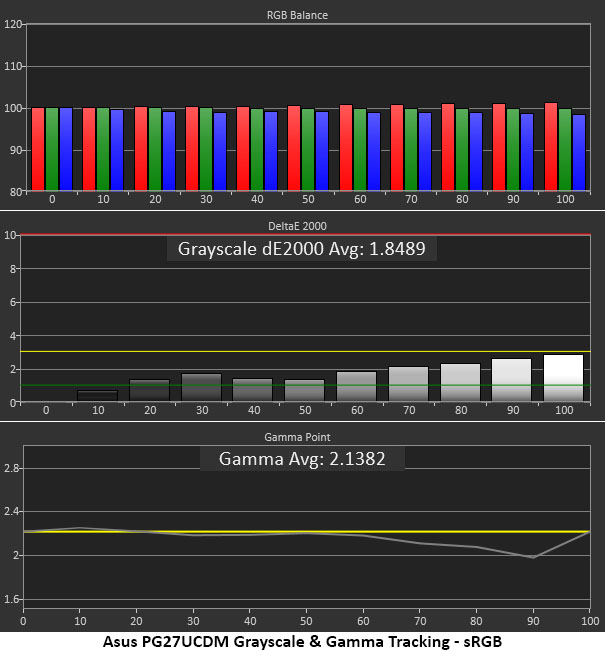
The only flaw in the PG27UCDM’s default chart is light gamma tracking. Grayscale is visually perfect with all values below 2dE. But gamma is a bit under the reference line with a 2.11 average. This is hard to spot in content, but with so much contrast available, a darker value will add texture to the image.
I calibrated the user color temp with its precise RGB sliders and achieved better grayscale tracking and improved gamma. It is now exactly on the line with a 2.2 average. It can’t get better than that.
The PG27UCDM has two ways to select sRGB. You can choose the sRGB Cal mode from GameVisual or retain calibration ability by simply sticking with Racing mode and picking the sRGB option from the Display Color Space sub-menu. The result is visually perfect grayscale and decent gamma that’s marred only by light values from 70-90%. This is still well within tolerance which makes the PG27UCDM qualified for color critical applications.
Comparisons
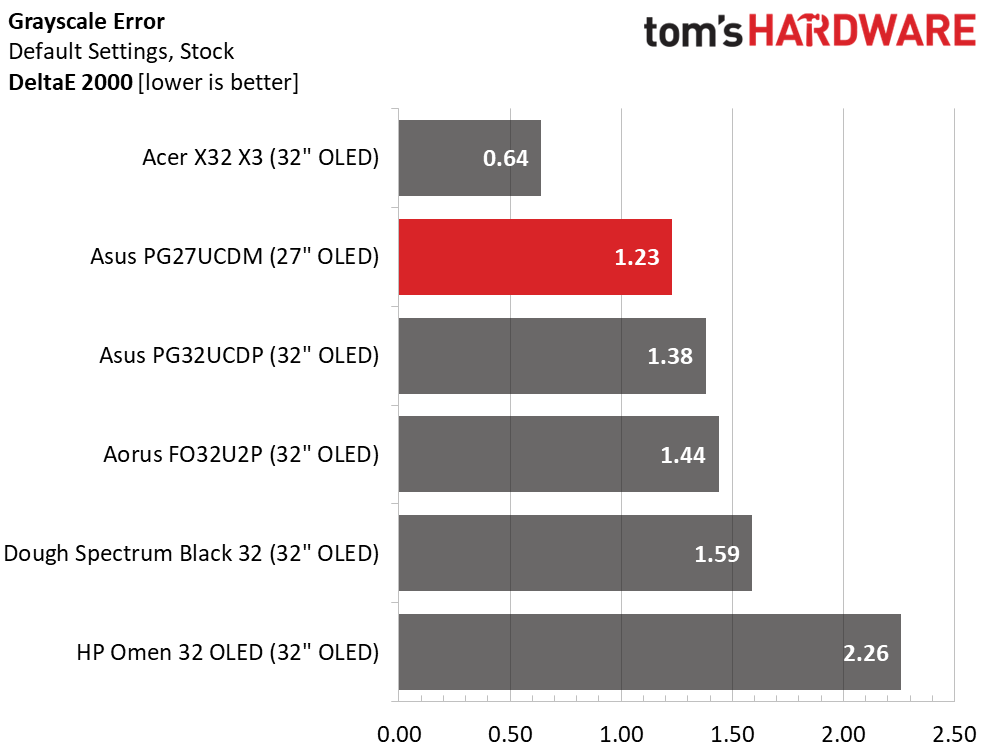
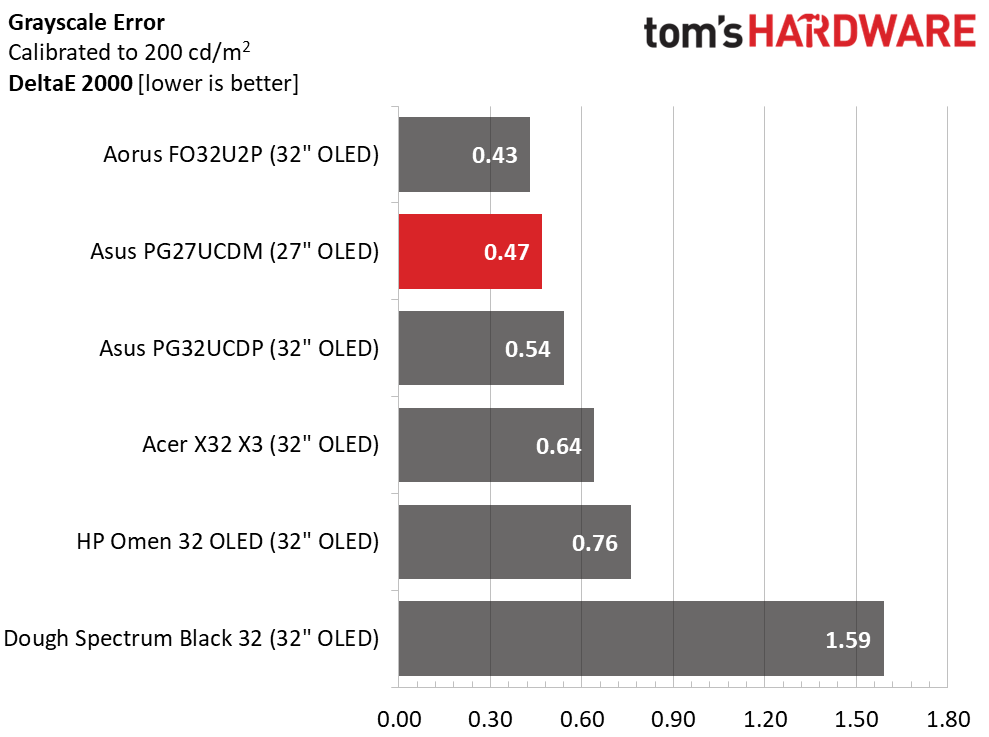
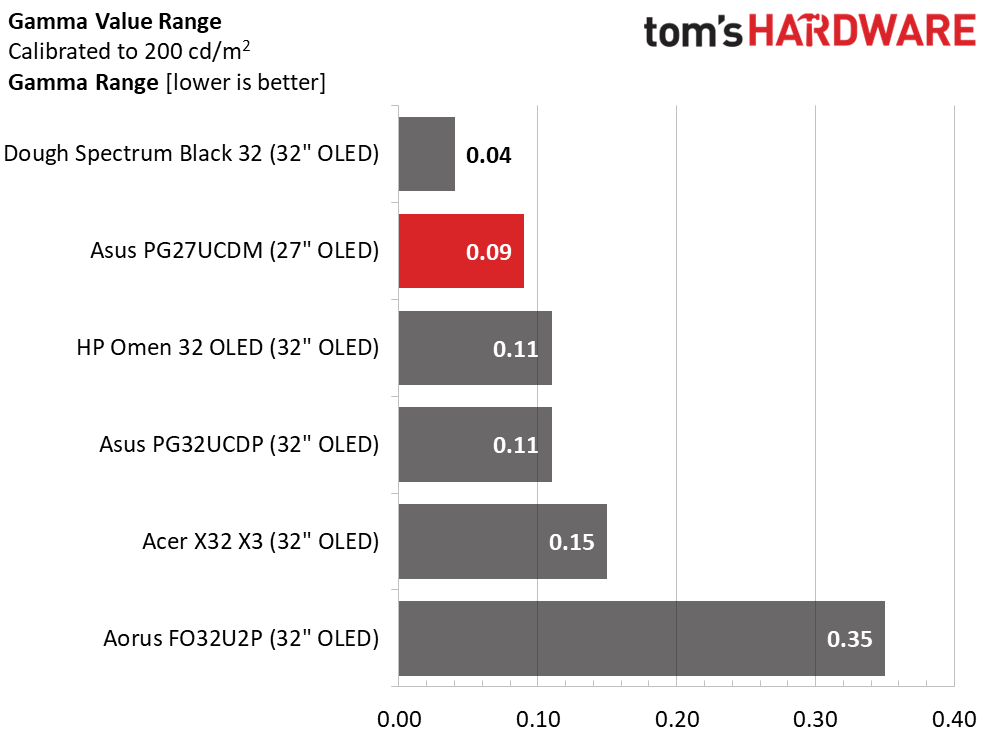
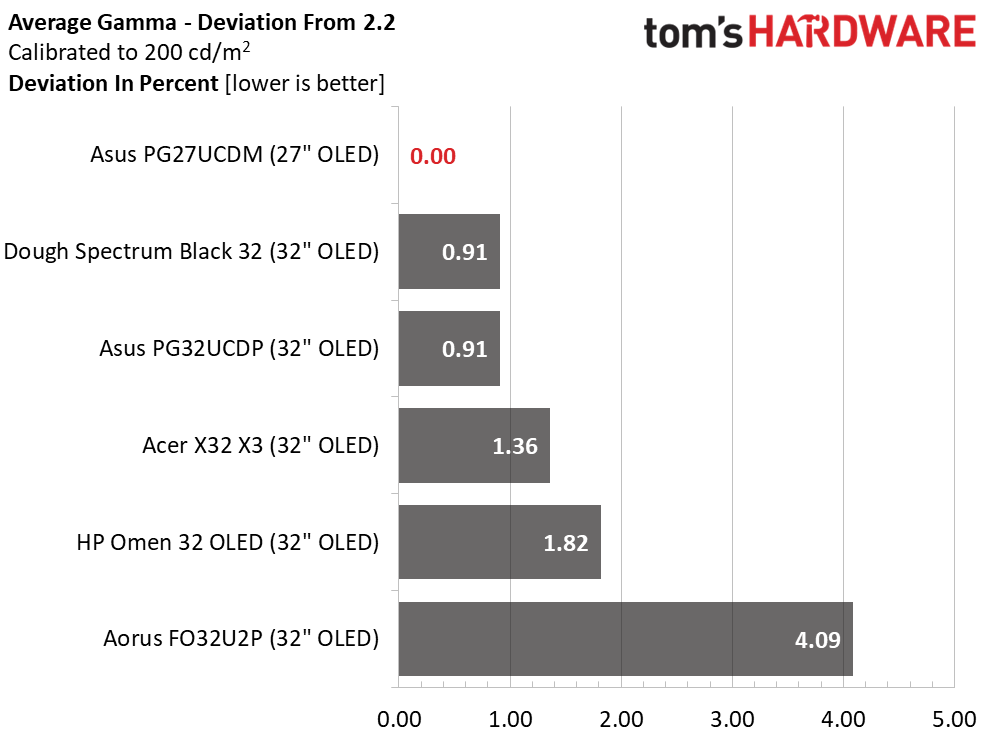
The PG27UCDM’s 1.23dE default grayscale is certainly impressive, but so is that of the other screens. None of them require calibration. These monitors are expensive. but their performance and accuracy justify the price. Calibration makes slight improvements across the board but visually, the differences are invisible.
The PG27UCDM manages better gamma results than all but the Dough, which has a slightly tighter value range. Errors are well below the visible point. All the monitors are super close except the Aorus, which runs a bit lighter than the rest.
Get Tom's Hardware's best news and in-depth reviews, straight to your inbox.
Color Gamut Accuracy
Our color gamut and volume testing use Portrait Displays’ Calman software. For details on our color gamut testing and volume calculations, click here.
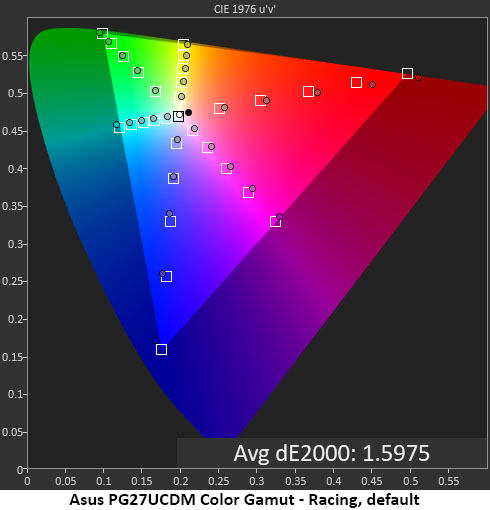
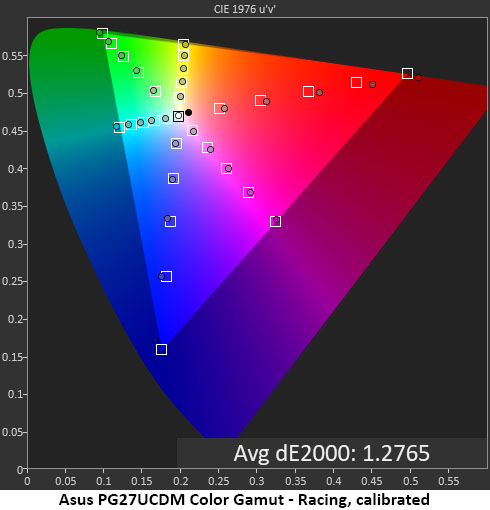
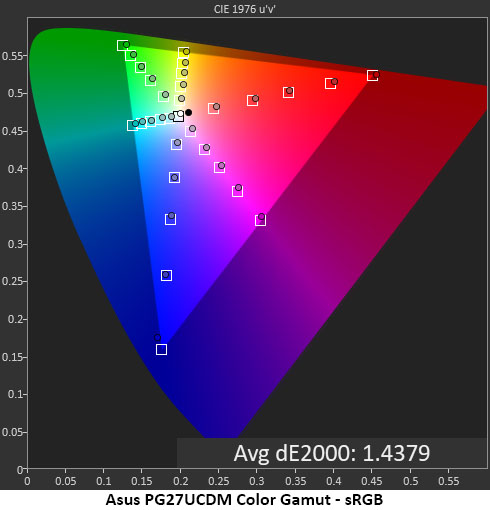
The PG27UCDM measures like other QD OLEDs with full coverage of the DCI-P3 gamut, plus a little bonus red. There is slight oversaturation, which is easy to spot in SDR content but nearly impossible to see in HDR mode. Hue and saturation points are all on or close to their targets. With a 1.60dE score out of the box, the PG27UCDM is visually free of errors. Calibration tightens up hue tracking a bit, but the visual change is minuscule.
The sRGB gamut option is also visually perfect with no points outside the target box. The PG27UCDM is fully qualified for color grading to DCI-P3 and sRGB specifications.
Comparisons
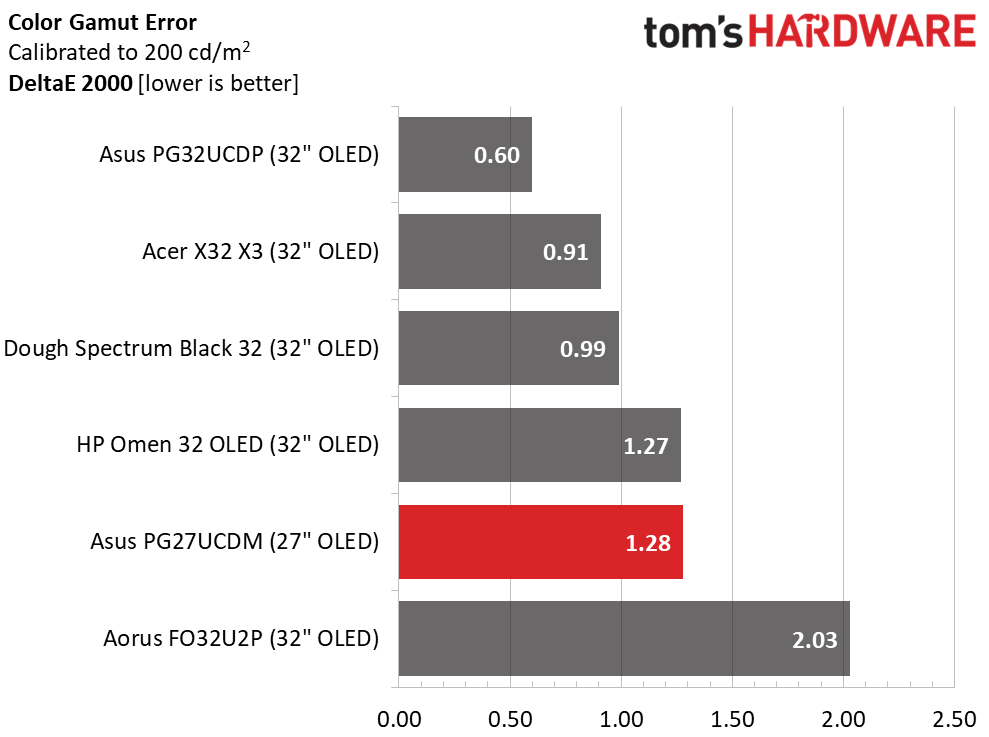
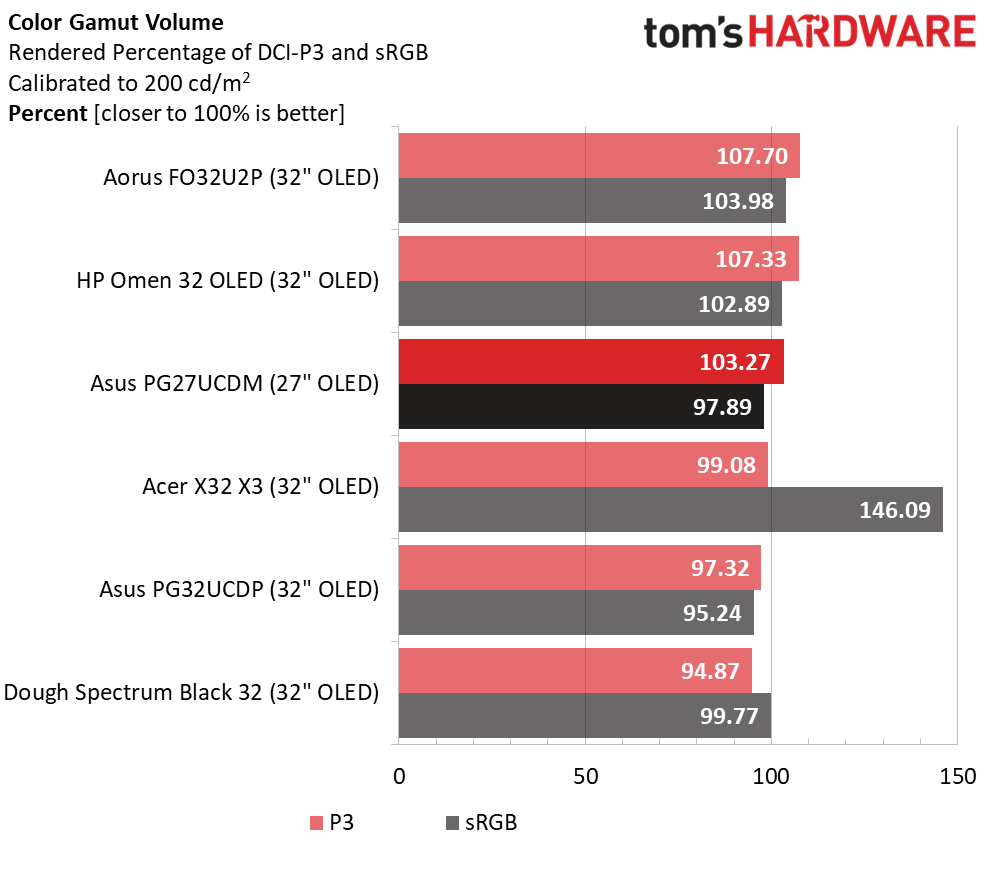
It would be easy to say it doesn’t get much better than the PG27UCDM’s 1.28dE color score if there weren’t four other monitors that measured lower. This is impressive performance, and it speaks to the consistent quality of the 4K OLED category, in which I have yet to see an underachiever.
In the volume test, it’s easy to spot the Quantum Dot panels. They’re the ones with over 100% coverage, like the PG27UCDM’s 103.27% score. The Aorus and HP screens have slightly greater volume, but this is a small difference in practice. You also get near-ideal sRGB coverage of 97.89%. If you’re looking for maximum OLED color, there are a few QHD screens that deliver around 110%, like the recently reviewed Samsung OLED G6 at 112%.
Test Takeaway: The PG27UCDM makes good use of its Quantum Dot panel with some bonus red, but its accuracy is what makes it a compelling choice. It doesn’t need calibration, and it is spot on for both sRGB and DCI-P3 mastered content. With extensive adjustment options, it’s well suited for tweakers. Color-wise, it is essentially flawless.
MORE: Best Gaming Monitors
MORE: How We Test PC Monitors
MORE: How to Buy a PC Monitor
Current page: Grayscale, Gamma and Color
Prev Page Brightness and Contrast Next Page HDR Performance
Christian Eberle is a Contributing Editor for Tom's Hardware US. He's a veteran reviewer of A/V equipment, specializing in monitors. Christian began his obsession with tech when he built his first PC in 1991, a 286 running DOS 3.0 at a blazing 12MHz. In 2006, he undertook training from the Imaging Science Foundation in video calibration and testing and thus started a passion for precise imaging that persists to this day. He is also a professional musician with a degree from the New England Conservatory as a classical bassoonist which he used to good effect as a performer with the West Point Army Band from 1987 to 2013. He enjoys watching movies and listening to high-end audio in his custom-built home theater and can be seen riding trails near his home on a race-ready ICE VTX recumbent trike. Christian enjoys the endless summer in Florida where he lives with his wife and Chihuahua and plays with orchestras around the state.
-
cknobman For gaming this is just a waste of money IMO.Reply
4k at this size does not offer much benefit unless you are a foot or less from the screen. -
Energy96 Reply
I disagree, unless you have cataracts the difference is very noticeable. I have a 27” 1440p and a 32” 4k as well on other machines. The difference is very noticeable even at the usual 2-3 ft from the screen, side by side is even more noticeable.cknobman said:For gaming this is just a waste of money IMO.
4k at this size does not offer much benefit unless you are a foot or less from the screen.
I had a high end 27” 4k IPS ASUS ROG Swift PG27UQ before I picked this monitor up last month and it’s really good. This one is even better and so much more colorful, the blacks are unbelievable. Side by side (currently the old IPS is used as second screen) the difference is ridiculous and that was a $1500+ IPS ROG monitor. Comparatively $1200 was a bargain.
The only minor annoyance is pixel refresher reminder pops up pretty frequently and is annoying when in the middle of playing something. I probably should just disable the reminder. Also the proximity sensor is not sensitive enough. I have often had it go black while I am sitting there playing a game but must have been very still. It does come back instantly if I move though. It would be better if it cross referenced lack of motion with any screen or mouse movement. It should only go black if the screen is also still. Minor things and all can be adjusted or disabled I suppose.
I don’t think a better screen exists in 27” size. -
PrazVT I don't have space for a 32" but I game at 4k, so I did pick this one up. I came from the LG 27" mini led, which was a nice monitor, but still had black crush / blooming issues despite the large # of dimming zones. I love the PG27UCDM so far. Between the feature set and image quality / performance it's just been a joy to use. The only real bug right now is with the proximity sensor. Despite a recent firmware update, the monitor will go dark after the timer even if you're in front of it and you have to wave your hand to get the monitor to come back on. So I have it disabled until they fix that. Otherwise, between the OLED Care features and just me being more mindful of the static content (b/c I use this monitor for productivity during the day) I am generally happy with the burn-in prevention features.Reply
Yes, the monitor is expensive for the size (ie...costs the same as my Sony OLED TV) ..but it is damn nice. -
RTX 2080 Reply
I’ve owned several monitors, including a 27 inch 4K monitor. It does offer a benefit.cknobman said:For gaming this is just a waste of money IMO.
4k at this size does not offer much benefit unless you are a foot or less from the screen. -
lmcnabney HDR10 is not exactly high end. That is where HDR starts. I would have expected HDR600 if not HDR1000 for this price. It is odd that OLED can't do it.Reply -
endocine Reply
Are you guys doing screen scaling or are you 100% default?Energy96 said:I don’t think a better screen exists in 27” size. -
UnforcedERROR Reply
These mean different things. HDR10 is a video standard. HDR600/1000 are specs relating to overall brightness. Having HDR10 is useful for media consumption as it's a fallback from Dolby Vision. HDR10 and Dolby Vision are also starting to be looked at as viable HDR solutions for gaming (which if you've gamed in HDR you know it's a crap shoot for quality).lmcnabney said:HDR10 is not exactly high end. That is where HDR starts. I would have expected HDR600 if not HDR1000 for this price. It is odd that OLED can't do it. -
Energy96 Reply
You are mixing up 2 different things.lmcnabney said:HDR10 is not exactly high end. That is where HDR starts. I would have expected HDR600 if not HDR1000 for this price. It is odd that OLED can't do it.
This OLED is about as bright as they get. -
Energy96 Reply
Are you talking about the windows setting or a game setting?endocine said:Are you guys doing screen scaling or are you 100% default?
Windows is at the usual recommended 150% when connecting a 4k monitor. 100% the text would be extremely small.
In games I always run native 4k scaling. -
lmcnabney Reply
OLED is intrinsically high in contrast. Brightness is not contrast. These panels may just be relatively low NITS.Energy96 said:You are mixing up 2 different things.
This OLED is about as bright as they get.
(pulls technical data on the display)
Yep, this display only does 250 nits across the panel and can get as high as 1000 nits, but only 3% of the display can be lit to attain that number. I suspect this low brightness is related to refresh or is required to lower the deterioration rate.
